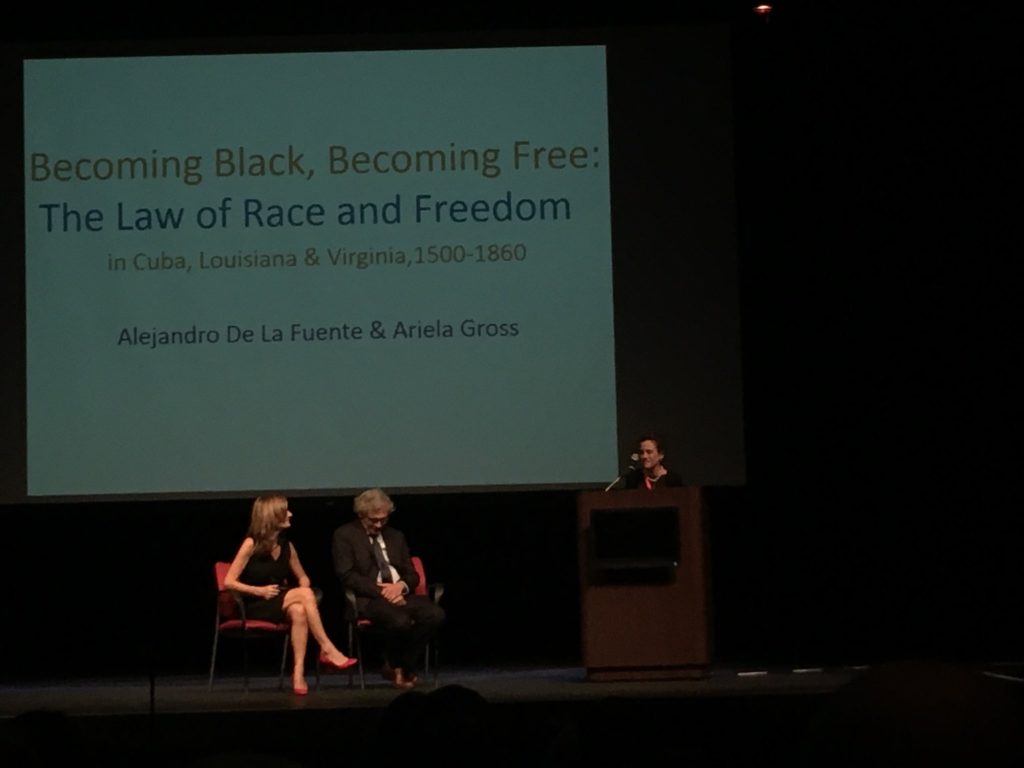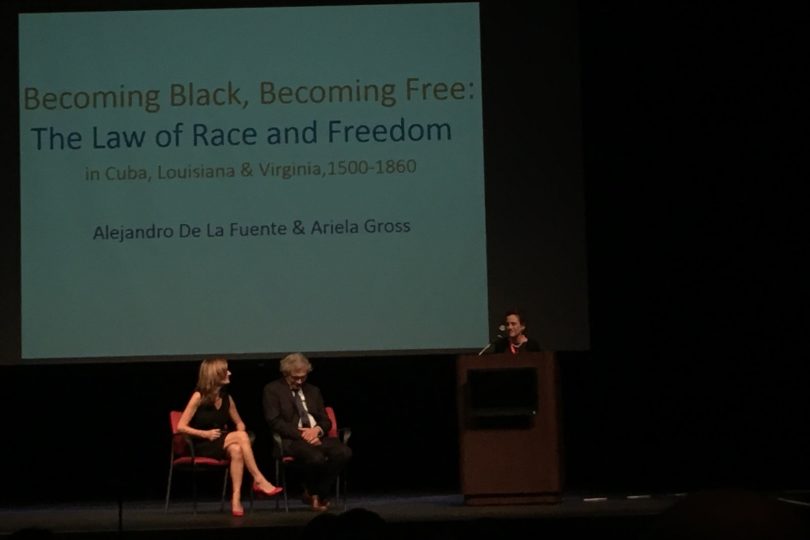Editor’s Note: This interview, conducted by Alexandra Havrylyshyn, was inspired by “Becoming Black, Becoming Free: The Law of Race and Freedom in Cuba, Virginia, and Louisiana, 1500-1860,” the plenary lecture by Professors Ariela Gross and Alejandro de la Fuente to the 2018 meeting of the American Society for Legal History.

Alexandra: This project began as an American Society for Legal History panel. How did it transform into a book? What motivated you to write it?
Alejandro: The book did not begin as a panel, although it was at an ASLH panel in 2002 that we first met. Most participants in the panel (Martha Jones, Walter Johnson, and Ariela) were scholars of the U.S. I was the only Latin Americanist, which is what made it interesting to me. Scholars of slavery and race in Latin America always think about the region, implicitly or explicitly, in comparative terms. The U.S., and the American scholarship on race and slavery, are always there. It is one of our challenges. And so I was interested in having conversations with colleagues across the traditional U.S.-Latin America divide, which is why I suspect Rebecca Scott, who organized the panel, invited me to participate. At that point I thought I would write a book about slaves and the law in Cuba, although I soon realized—and this realization took place in the midst of conversations such as those at the ASLH panel—that what I really wanted to do was to write a comparative book, was to embrace the sort of comparative questions that have guided much of our research for this volume. It was something that I knew I could not do by myself. Ariela was interested in some of the same questions, but it was not until 2010 that we published our first paper together.
Ariela: The truth is, I have no memory of that panel or what I presented there, but Alejandro found the program online, so I have to believe the documentary evidence! I think part of why I don’t remember that panel specifically, is that it was the first of so many conversations among Alejandro, Martha, Rebecca, Jean Hébrard, Michael Zeuske, Ada Ferrer, and me, in many different workshops and conferences, over the last nearly two decades. I am pretty sure that Alejandro and I first discussed collaborating on a comparative project in 2006, in Los Angeles, and although that afternoon we sketched out a pretty ambitious idea – which is eventually resulting in a book – the first step that we took was a review of the literature for the Annual Review of Law and Social Sciences that allowed us to survey the field and see where the work had been done and what big questions needed to be asked and answered.
Alexandra: While several recent histories of law and slavery employ transnational and microhistorical methods, you employ comparative methods. How do decades of legal history-from-below scholarship change older comparative slavery studies, such as Frank Tannenbaum’s Slave and Citizen (1947)?
Alejandro: The excellent transnational studies and microhistories of recent decades have changed how we think about comparative history, in the sense that no serious scholar would treat “Anglo-Saxon” and “Latin” America today as two sealed, independent, and distinct analytical units, the way Tannenbaum did in the mid-20th century. Race-making processes are never nationally bound—and the very idea of “national” is any case anachronistic for the period that we study in the Americas. The same applies to the slave trade, to abolitionism, and to the impact, influence and ripple effects of processes such as the Haitian Revolution, to mention just a few obvious examples that have received scholarly attention. Legal historical approaches from below have also changed how we think about “the law,” not as a body of written rules or statutes, but as contentious social spaces where different claims are articulated by a multitude of actors, including slaves themselves.
Ariela: That’s exactly right, but I think the emphasis on transnational micro-history, as well as the devastating critiques of top-down comparisons, have also discouraged people from even asking comparative questions – and we are trying to bring some of those questions back to the forefront. After all, legal regimes do follow borders, even as those borders are porous and legal pluralism often prevails under empires. We took on this project because we believe it’s worth asking what difference legal regimes make to the development of regimes of race and slavery – a question that comes into relief with a comparative approach.
Alexandra: How does your race-conscious research revise older comparative accounts of law and slavery?
Alejandro: We emphasize a foundational commonality among these jurisdictions: legislators in each of them sought to build racial orders in which blackness was not only a debased social category, but one that was basically indistinguishable from enslavement. The Iberians led the way, as many of them were already familiar with slavery and also with Sub Saharan Africans, whose numbers were growing fast in the Iberian Peninsula by the early 16th century. The earliest ordinances concerning slaves in the Spanish colonies, dated in the 1520s, already treated “negros” and “esclavos” as more or less synonymous concepts. But the formation of communities of free people of color in the Spanish colonies undermined this association, leading in the long term to understandings of race and status that could not simply or easily conflate blackness with enslavement. Free black communities represented a formidable barrier against black debasement.
Ariela: It’s also important to say that we are ultimately concerned not with giving an account of the law of slavery, but of race. We argue that it was not the law of slavery but the law of freedom that was most crucial for the creation of racial regimes in law. The laws regulating manumission and freedom suits determined whether it was possible to move from slave to free status, under what circumstances, and whether race would become the primary basis for claims to freedom. Laws regulating the lives and institutions of free people of color created the boundaries between black and white, the rights that would be reserved to white people, and the degradations imposed only on black people. We challenge the traditional view of a contrast between a racially fluid system in Latin America that recognized the slave as a person, and a harsher binary system in the British colonies that saw the slave only as chattel. It was not whether a society recognized slaves’ humanity, nor its racial fluidity, that marked the differences among Cuba, Virginia, and Louisiana. It was how successfully the elites of that society drew the connections between blackness and enslavement on the one hand, whiteness, freedom, and citizenship on the other. This varied over time, and to some extent, the greatest surprise for me was how late the real differences among these societies was cemented – in the last decades of slavery.
Alexandra: Your book spans the period 1500 to 1860. What challenges, if any, did you encounter when working on such a long time scale?
Alejandro: One of the main methodological pitfalls of Tannenbaum’s work and of some of his followers was precisely their lack of attention to change across time. So this became a central question for us from the very beginning. One important challenge was how to think about a periodization that encompassed the various jurisdictions that we study, time frames that worked for each and all of them. That explains, at least in part, why it took us several years to finish this project.
Ariela: Yes, and in my case, the seventeenth and eighteenth century material was really new to me. Alejandro had worked extensively in the Cuban archival materials spanning the entire period, but I had not worked on colonial Virginia or Louisiana at all. For Louisiana, that meant work in both Spanish and French colonial records. In all, we collected hundreds of freedom suits and other cases involving free people of color from Virginia and Louisiana that have not been written about before. We also both spent time immersing ourselves in the literature and digital archives of the “other”: Alejandro read deeply in the Virginia and Louisiana material, and I learned as much as I could about Cuba without visiting the Cuban archives myself.
Alexandra: Orlando Patterson famously argued in Slavery and Social Death (1982) that manumission, or the freeing of individual slaves while the institution of slavery remains intact, is ultimately the power of the master. Do you agree, and why or why not?
Alejandro: Manumission is, in fact, a slaveowner’s right. But it is the sort of right that was constantly shaped, contested, and defined, sometimes in fairly fundamental ways, by slaves’ actions and goals. For instance, self-purchase may require the master’s consent—although even this became contested in some places and times—but who got to obtain freedom was frequently a decision taken by slaves themselves, depending on personal and collective circumstances, like family strategies and priorities. It is surely not a coincidence that manumission rates were considerably higher for women. This was in part a reflection of unusual opportunities to benefit from social networks and from access to financial resources, but it was also a calculation to guarantee that the progeny of such women would be born in freedom. On top of that, we show in the book that under some circumstances, slaves managed to transform manumission into a right that could be claimed and exercised even against the will of the owners. To owners that was nothing short of an assault on property rights.
Ariela: Alejandro sums it up perfectly. One of the lessons I’ve learned from the study of law “from below” is that we can get a sense of when “subaltern” people are shaping the law from how much anxiety they provoke in the master class. The fact that slaveholders across our jurisdictions complained bitterly about the rights enslaved people carved out for themselves in suing for freedom suggests that they felt threatened by these claims. We also argue that it’s particularly important in revolutionary Virginia that petitioners to the legislature complaining about the expansion of manumission begin to connect individual manumission to the revolutionary prospect of general emancipation, calling it “partial emancipation.” In Spanish Louisiana and Cuba, they were much more likely to see manumission as precisely what Patterson described, a traditional practice of the master’s prerogative.
Alexandra: In the historical discipline we sometimes see collaborative research but we do not often see collaborative writing. What was your co-writing process? What lessons would you impart to other legal historians who may be interested in co-authorship?
Alejandro: The co-writing process turned out to be way simpler than we ourselves imagined. We shared primary documents across locations, which gave each of us the opportunity to produce first drafts of chapters and to write about all locations, regardless of our own strengths. Each of these drafts was subsequently rewritten several times by each of us, to the point that it would be nearly impossible now to establish who authored specific paragraphs or even sentences. It is a truly joint effort. We highly recommend this type of collaboration, as it is otherwise nearly impossible to tackle the sort of questions that we try to answer and to master the amount of primary and secondary materials required to write a book like this.
Ariela: We were on a panel about collaboration recently where one of our co-panelists (herself a partner in a very successful writing collaboration) said that it gets more difficult towards the end, because if they had left any issues to be decided, they would have to come to a resolution at the end. I found it exactly the opposite: early on, we disagreed, argued, rewrote, convinced, proved and disproved, and by the end, found ourselves much more aligned and working much more smoothly than at the outset. It was a great experience.
Alexandra: What questions does your book raise but leave unanswered? That is, what kinds of studies do you hope your book will inspire?
Alejandro: Perhaps the most important question that we raise, but do not answer, concerns the long-term impact of these legal regimes of race after emancipation. This is an old question, a question that was in fact at the center of Tannenbaum’s volume. Unlike him, however, we argue that what matters in the formation of post-emancipation societies is not the law of slavery—the question of whether slaves were endowed with “moral personalities” or not—but the law of race, which probably continued to shape social relations, struggles, and opportunities after slavery ended. But that is the subject of another book. Whether we will write that book remains, for now, just a possibility.
Ariela: What he said.





